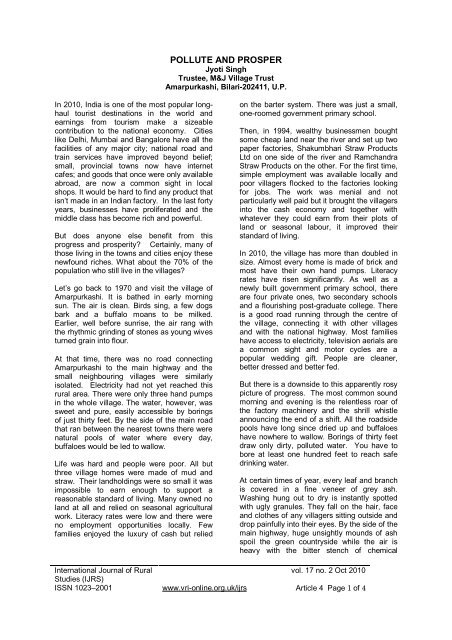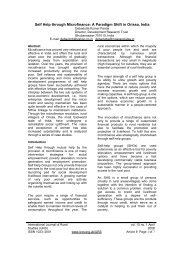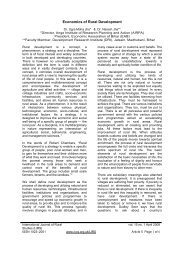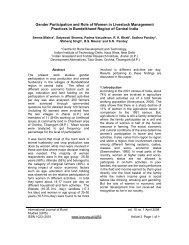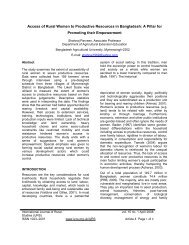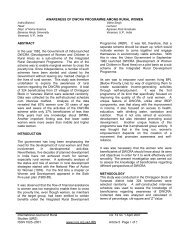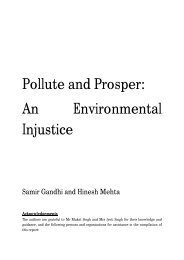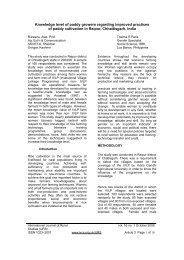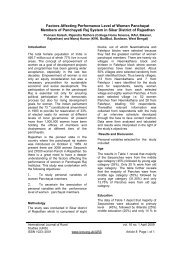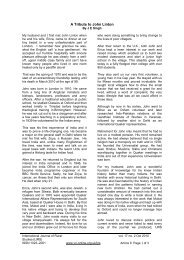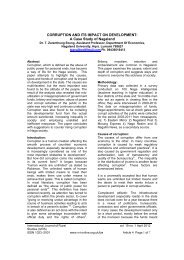4. Pollute and Prosper - Volunteers for Rural India
4. Pollute and Prosper - Volunteers for Rural India
4. Pollute and Prosper - Volunteers for Rural India
- No tags were found...
Create successful ePaper yourself
Turn your PDF publications into a flip-book with our unique Google optimized e-Paper software.
POLLUTE AND PROSPERJyoti SinghTrustee, M&J Village TrustAmarpurkashi, Bilari-202411, U.P.In 2010, <strong>India</strong> is one of the most popular longhaultourist destinations in the world <strong>and</strong>earnings from tourism make a sizeablecontribution to the national economy. Citieslike Delhi, Mumbai <strong>and</strong> Bangalore have all thefacilities of any major city; national road <strong>and</strong>train services have improved beyond belief;small, provincial towns now have internetcafes; <strong>and</strong> goods that once were only availableabroad, are now a common sight in localshops. It would be hard to find any product thatisn’t made in an <strong>India</strong>n factory. In the last <strong>for</strong>tyyears, businesses have proliferated <strong>and</strong> themiddle class has become rich <strong>and</strong> powerful.But does anyone else benefit from thisprogress <strong>and</strong> prosperity? Certainly, many ofthose living in the towns <strong>and</strong> cities enjoy thesenewfound riches. What about the 70% of thepopulation who still live in the villages?Let’s go back to 1970 <strong>and</strong> visit the village ofAmarpurkashi. It is bathed in early morningsun. The air is clean. Birds sing, a few dogsbark <strong>and</strong> a buffalo moans to be milked.Earlier, well be<strong>for</strong>e sunrise, the air rang withthe rhythmic grinding of stones as young wivesturned grain into flour.At that time, there was no road connectingAmarpurkashi to the main highway <strong>and</strong> thesmall neighbouring villages were similarlyisolated. Electricity had not yet reached thisrural area. There were only three h<strong>and</strong> pumpsin the whole village. The water, however, wassweet <strong>and</strong> pure, easily accessible by boringsof just thirty feet. By the side of the main roadthat ran between the nearest towns there werenatural pools of water where every day,buffaloes would be led to wallow.Life was hard <strong>and</strong> people were poor. All butthree village homes were made of mud <strong>and</strong>straw. Their l<strong>and</strong>holdings were so small it wasimpossible to earn enough to support areasonable st<strong>and</strong>ard of living. Many owned nol<strong>and</strong> at all <strong>and</strong> relied on seasonal agriculturalwork. Literacy rates were low <strong>and</strong> there wereno employment opportunities locally. Fewfamilies enjoyed the luxury of cash but reliedon the barter system. There was just a small,one-roomed government primary school.Then, in 1994, wealthy businessmen boughtsome cheap l<strong>and</strong> near the river <strong>and</strong> set up twopaper factories, Shakumbhari Straw ProductsLtd on one side of the river <strong>and</strong> Ramch<strong>and</strong>raStraw Products on the other. For the first time,simple employment was available locally <strong>and</strong>poor villagers flocked to the factories looking<strong>for</strong> jobs. The work was menial <strong>and</strong> notparticularly well paid but it brought the villagersinto the cash economy <strong>and</strong> together withwhatever they could earn from their plots ofl<strong>and</strong> or seasonal labour, it improved theirst<strong>and</strong>ard of living.In 2010, the village has more than doubled insize. Almost every home is made of brick <strong>and</strong>most have their own h<strong>and</strong> pumps. Literacyrates have risen significantly. As well as anewly built government primary school, thereare four private ones, two secondary schools<strong>and</strong> a flourishing post-graduate college. Thereis a good road running through the centre ofthe village, connecting it with other villages<strong>and</strong> with the national highway. Most familieshave access to electricity, television aerials area common sight <strong>and</strong> motor cycles are apopular wedding gift. People are cleaner,better dressed <strong>and</strong> better fed.But there is a downside to this apparently rosypicture of progress. The most common soundmorning <strong>and</strong> evening is the relentless roar ofthe factory machinery <strong>and</strong> the shrill whistleannouncing the end of a shift. All the roadsidepools have long since dried up <strong>and</strong> buffaloeshave nowhere to wallow. Borings of thirty feetdraw only dirty, polluted water. You have tobore at least one hundred feet to reach safedrinking water.At certain times of year, every leaf <strong>and</strong> branchis covered in a fine veneer of grey ash.Washing hung out to dry is instantly spottedwith ugly granules. They fall on the hair, face<strong>and</strong> clothes of any villagers sitting outside <strong>and</strong>drop painfully into their eyes. By the side of themain highway, huge unsightly mounds of ashspoil the green countryside while the air isheavy with the bitter stench of chemicalInternational Journal of <strong>Rural</strong>vol. 17 no. 2 Oct 2010Studies (IJRS)ISSN 1023–2001 www.vri-online.org.uk/ijrs Article 4 Page 1 of 4
effluents. The Aril River is just thick, stagnantsludge while crops in the fields adjacent to thefactory are thin <strong>and</strong> grey, slowly dying from thepolluting liquids that regularly pour from thefactory outlet pipe. New illnesses are nowcommon, among them a virulent <strong>for</strong>m ofasthma <strong>and</strong> life-threatening jaundice.The Struggle beginsIn December 1995, Suresh Atri, a retiredenvironmental engineer, sent detailedcomplaints to the Central Pollution ControlBoard <strong>and</strong> made a number of requests:• Improve the drainage capacity of theAril River• Do not release any more effluents intothe river• Get the factory to manage its solidwaste disposal• Arrange compensation <strong>for</strong> damagedcrops• Close the factory until the above havebeen implementedThere was no reply although a reminder wassent four months later <strong>and</strong> the regionalnewspaper published the letter in full.Since then, there have been numerous articles<strong>and</strong> reports in the local papers <strong>and</strong> severalseminars. Farmers have h<strong>and</strong>ed in manymemor<strong>and</strong>a at the Tehsil Diwas (Public OpenDay). More than thirty letters of complainthave been sent to the District Magistrate <strong>and</strong>the Sub-Divisional Magistrate as well as to theDivisional Commissioner <strong>and</strong> the U.P.Pollution Control Board. In February 2008, apeaceful dharna (sit-in) began. At the end ofeach day, emails were sent to nearly fiftygovernment officials, in<strong>for</strong>ming them of theaction <strong>and</strong> the extent of the pollution <strong>and</strong>suggesting ways <strong>for</strong>ward that would benefitboth the factory <strong>and</strong> the local villagers.When this too had no effect, overseas visitorswho had witnessed the ever increasingenvironmental pollution at first h<strong>and</strong>, sentscores of emails to key officers <strong>and</strong> politicians,requesting urgent action. At the beginning of2010, some 500 postcards were sent by localpeople, begging the government to investigatethe matter.Once again, nothing was done.TestsThe water of the river had been tested by anindependent laboratory in April 2002. Theresults showed significant pollution. InFebruary 2010, the U.P. Pollution ControlBoard arranged their own tests which,strangely, showed that nothing was wrong atall. Finally, in April 2010, a governmentlaboratory in Moradabad sent officers to collectsamples <strong>and</strong> test them. They found extremelyhigh levels of pollution, way above theprescribed limits set both nationally <strong>and</strong>internationally. Two of these results are givenbelow:-T.S.S. Total Suspended Solids.St<strong>and</strong>ard prescribed by the U.P. Pollution Control Board - In stream - 100/50/30 mg/ltP.S.I., Dehra DunApril 2002RTC Lab.,Moradabad, Govt.of <strong>India</strong> April 20101500 2900 1780 100/50/30 mg/lt4750 6150 3420 100/50/30 mg/ltRegional officeof U.P. PCB(Moradabad)Feb. 201096.0 9<strong>4.</strong>0 Not done 100/50/30 mg/ltT.S.S. or total suspended solids are organic<strong>and</strong> inorganic materials suspended in thewater, including silt, plankton <strong>and</strong> industrialwastes. High concentrations of suspendedsolids can lower water quality by absorbinglight. The water then becomes warmer <strong>and</strong> isnot able to hold the oxygen necessary <strong>for</strong>aquatic life. Because aquatic plants alsoInternational Journal of <strong>Rural</strong>vol. 17 no. 2 Oct 2010Studies (IJRS)ISSN 1023–2001 www.vri-online.org.uk/ijrs Article 4 Page 2 of 4
eceive less light, photosynthesis decreases<strong>and</strong> less oxygen is produced. The combinationof warmer water, less light <strong>and</strong> less oxygenmakes it impossible <strong>for</strong> some <strong>for</strong>ms of life toexist.Suspended solids affect life in other ways.They can clog fish gills, reduce growth rates,decrease resistance to disease, <strong>and</strong> preventegg <strong>and</strong> larval development. Particles thatsettle out can smother fish eggs <strong>and</strong> those ofaquatic insects, as well as suffocate newlyhatchedlarvae.Suspended solids can result from erosion fromurban runoff <strong>and</strong> agricultural l<strong>and</strong>, industrialwastes, bank erosion, algae growth orwastewater discharges. The above tableshows that the TSS was already, in 2002, wayabove the prescribed limit. By 2010, accordingto the government laboratory, it had increasedeven further. Only the test carried out by thePollution Control Board shows normal results.It is interesting to note that when the officerscome from the PCB, they always in<strong>for</strong>m thefactory be<strong>for</strong>eh<strong>and</strong> <strong>and</strong> only take samplesfrom the outlet of the treatment plant <strong>and</strong>always in front of the manager. They neverraise any queries about the noxious stink ofthe encrusted sludge that is all that remains ofthe river or the enormous piles of ash by theroadside <strong>and</strong> encroaching on farmers’ fields.They don’t speak to any local villagers whocould tell them that the treatment plant is onlyrun when officials come to check the factory.The rest of the time it lies still.BOD – Biochemical Oxygen Dem<strong>and</strong>St<strong>and</strong>ard prescribed by U.P. Pollution Control BoardIn stream – 30 mg/ltP.S.I., Dehra DunApril 2002RTC Lab.Moradabad, Govt.of <strong>India</strong> April 20101070 1370 1400 20mg/lt2450 3870 2370 20mg/ltRegional officeof U.P. PCB(Moradabad)Feb. 20102<strong>4.</strong>0 28.0 26.0 30mg/ltMicro-organisms such as bacteria areresponsible <strong>for</strong> decomposing organic waste.When organic matter such as dead plants,leaves, grass clippings, manure, sewage, oreven food waste is present in a water supply,the bacteria will begin breaking down thiswaste. Much of the available dissolved oxygenis then consumed by aerobic bacteria, robbingother aquatic organisms of the oxygen theyneed to live.Biological Oxygen Dem<strong>and</strong> (BOD) is ameasure of the oxygen used by microorganismsto decompose this waste. If there isa large quantity of organic waste in the watersupply, there will also be a lot of bacteriapresent working to decompose this waste. Inthis case, the dem<strong>and</strong> <strong>for</strong> oxygen will be highso the BOD level will be high.When BOD levels are high, dissolved oxygenlevels decrease because the oxygen that isavailable in the water is being consumed bythe bacteria. Since less dissolved oxygen, it isdifficult <strong>for</strong> fish <strong>and</strong> other aquatic organisms tosurvive.Research ResultsFrom October to December 2009, two younggraduates of Britain’s prestigious LondonSchool of Economics stayed in Amarpurkashicarrying out research into the pollution. Thefollowing are extracts from theircomprehensive report.“The black ash emitted from SSPL’ssmokestacks has settled on vegetation,agricultural l<strong>and</strong> <strong>and</strong> people. It has had aneffect on eyesight, <strong>and</strong> caused seriousrespiratory problems. The ash is not containedby the plant, <strong>and</strong> it seems the ash has notbeen treated either. The smell that arises fromthe site is unbearable <strong>and</strong> radiates over aInternational Journal of <strong>Rural</strong>vol. 17 no. 2 Oct 2010Studies (IJRS)ISSN 1023–2001 www.vri-online.org.uk/ijrs Article 4 Page 3 of 4


